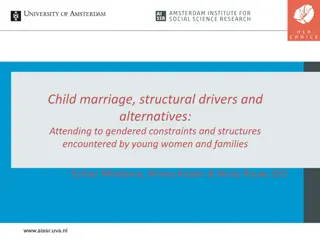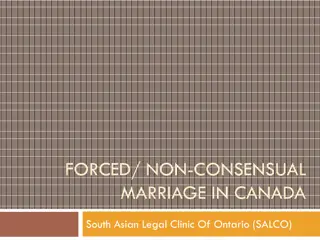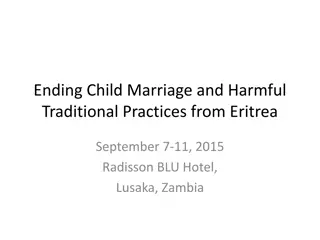Understanding the Various Aspects of Marriage
Marriage is a legal union between individuals of the opposite sex, established through civil, religious, or other means. It can be categorized into types like monogamy and polygamy, and measured through rates like the Crude Marriage Rate (CMR) and General Marriage Rate (GMR). The CMR reflects the number of marriages per 1,000 population, while the GMR focuses on marriages among individuals aged 15 and older. These measurements may be affected by factors like age structure of the population.
Download Presentation

Please find below an Image/Link to download the presentation.
The content on the website is provided AS IS for your information and personal use only. It may not be sold, licensed, or shared on other websites without obtaining consent from the author. Download presentation by click this link. If you encounter any issues during the download, it is possible that the publisher has removed the file from their server.
E N D
Presentation Transcript
Marriage Marriage Legal union of persons of opposite Legal union of persons of opposite sex sex The legality of the union may be The legality of the union may be established by civil, religious, or established by civil, religious, or other means as recognized by the other means as recognized by the laws of each laws of each 2
Types of marriage: 1- Monogamy: is a form of marriage in which an individual has only one spouse during their life time. 2- Polygamy: Is a form of marriage where a man is married to more than one wife at a time. 3
The measurement of marriage: 1- Crude marriage rate (CMR): marriage in year Mid-year population CMR = X 1000 4
Example: In a certain community, the number of marriages in 1412H was 1404. The number of people at the mid-year was 194,650. 5
1404 194650 X 1000= 7.2/1000 CMR = Note that: 1- Numerator is the number of marriages, rather the number of persons getting married. For this reason the rate tend to be low, since there will be only one event in the numerator per two people in the denominator. 6
2- It has the deficiency that the denominator is the total population, including children and others not currently at risk of marrying (currently married) or divorcing. 3- Age structure of the population also affects CMR. 7
General marriage rate (GMR): Marriages Mid-year age 15+ X 1000 GMR = General Marriage Rate is the number of marriages per 1,000 population age 15 and older 8
Example: In the previous example, if the number of those who were below 15 was 68512 calculate CMR: To get the number who were 15+, we deduct the number of those who were less than 15 from mid- year population, that is: 9
194650 68512 = 126138 1404 126138 X 1000 = 11.13/1000 CMR = 10
General Marriage Rate can also be General Marriage Rate can also be obtained separately for Women and obtained separately for Women and Men Men General marriage rate for women (GMRf) Marriages Mid-year female15+ X 1000 GMRf = 11
General marriage rate for men(GMRm) Marriages Mid-year male15+ X 1000 GMRm = 12
Exercise Exercise General Marriage Rate General Marriage Rate Calculate the general marriage rate for women and compare it to the general marriage rate for Brazil (1988) based on the following data 13
Brazil, 1988 Number of marriages : 951 236 Total population 15+ : 92 852 000 Total female population 15+: 46,706 000 Answers: 1 1- - GMR = GMR = 10.24 2 2- - GMRf GMRf = 10.24 = 20.37 14
Age specific marriage rate: The Timing of marriage is a basic consideration in explaining fertility trends: Early marriage is associated with higher fertility, together with high proportions remaining unmarried is associated with lower fertility. 15
age specific rates are valuable for showing whether marriage is occurring early or late. The rates are often calculated separately for each sex, because of each differences between spouses. 16
Age specific marriage rate ASMR (females): ASMR = Marriages for females aged x to x + n X 1000 Mid-year female population aged x to x + n 17
age specific marriage rate for Australia 2000 Women marrying Marriage rate/1000 age Mid-year population females 65805 66587 73273 71211 74916 72366 65210 intervals 15 - 19 20 24 25 29 30 34 35 39 40 44 45 - 49 18 322 2733 3772 1943 995 590 280 4.9 41.5 51.5 27.3 13.3 8.2 4.3
For example, age specific marriage in the interval (25 29) can be obtained as: ASMR (F, 25 29)= 3772 73273 X 1000 = 51.5/1000 19
Total marriage rate (TMR): The ASMR can be summed to form Total marriage rate in analogous way to the total fertility rate. For our example, this can be calculated as: (4.9 + 41.5 + 51.5 + 27.3 + 13.3 + 8.2 + 4.3) x 5 1000 20
0.755 This could be interpreted as the proportion of women who could eventually marry if the age specific rates are prevailed. 21
Standardization Standardization Most of the marriage measures can and should be standardized for comparisons Can be done by direct or indirect method Used for comparative marriage analyses 22
Example: Age-standardized first marriage rate of the U.S. (1960), using England and Wales (1961) as standard-direct method 23
Age groups Male ist marriage rates US Sibgle male population Expected ist marriage USA 15 - 19 20 - 24 25 - 29 30 - 34 35 - 44 45 - 64 65+ 0.031 0.210 0.190 0.111 0.06 0.019 0.011 70.7 1,604,910 49,752 989,961 425,643 262,656 373,918 498,549 158,146 4,314,183 401,262 207,829 80,872 29,155 22,435 9,472 1,747 24
U.S. age-standardized first marriage rate = 401,262 / 4,314,183 x 1,000 = 93 25
Indicators of Divorce Indicators of Divorce 26
Divorce Divorce Separation of the husband and wife by a judicial decree which confers on the parties the right to remarriage 27
1- Crude divorce rate (CDR) Number of divorces per 1,000 population Number of divorces CDR = X 1000 Mid-year population 28
General Divorce Rate (GDR) General Divorce Rate (GDR): : Is the umber of divorces per 1,000 persons age 15 and more Number of divorces X 1000 GDR = Mid-year pop 15+ 29
Calculate the crude divorce rate and the general divorce rate for Brazil (1988) based on the data: Number of divorces : 33,437 Total population 15+: 92,852,000 Total population : 144,428,000 30
Crude Crude Divorce Rate Divorce Rate = 6.45 6.45 divorces per divorces per 1,000 = 1,000 population population General Divorce Rate General Divorce Rate = 10.03 10.03 divorces per divorces per 1,000 age age 15 15+ + = persons 1,000 persons 31
Divorce Rate Among Married Couples Divorce Rate Among Married Couples Is the Number of divorces per 1,000 married persons (DRM) Number of divorces Mid-year pop among married X 1000 DRM= 32
Age Age- -Specific Divorce Rate (ASDR) Specific Divorce Rate (ASDR) Is the number of divorces per 1,000 women (or men) of age a ASDR= Divorces by women age a Mid-year pop women age a X 1000 33
Exercis Exercise e Calculate the age-specific divorce rates for women 30 34 and 40 44 for Brazil (1988) based on the following data: Age groups divorces population 30 - 34 6689 5,443,000 40 - 44 4825 3,590,000 34
Age-specific divorce rate: 1.23 divorces per 1,000 women 1.23 divorces per 1,000 women 30 30 34 34 1.34 divorces per 1,000 women 1.34 divorces per 1,000 women 40 40 44 44 35























